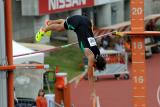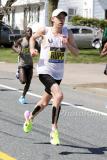Folders |
Rupp Discusses Tough Winter Dealing With Plantar FasciitisPublished by
Rupp overcomes frustrating winter with plantar fasciitis By Doug Binder, DyeStat Editor Anyone who has woken up to the pain of an aching heel knows that plantar fasciitis is an unwelcome injury that often takes months to go away. Galen Rupp certainly knows all about it. The two-time Olympian began to feel the discomfort of plantar fasciitis in December and as the weeks turned into months, he wrestled not only with the unshakable pain but also frustration. “It was rough,” Rupp said. “As anyone who has had it knows, it may feel like it’s starting to get better sometimes, you start thinking, ‘I’m finally over the hump,’ and then it’s sore again.” Rupp finished second April 17 at the Boston Marathon, but his arrival at the starting line was in doubt until the final two weeks before the race. The issue was plantar fasciitis, a somewhat common malady that affects everyday walkers as well as runners. Plantar fasciitis is a condition typically caused by micro tears to the connective tissue that attaches to the heel bone. It afflicts overweight non-runners as well as elite athletes. Rupp had to curtail any plans for an ambitious winter of training to deal with a stubborn injury that wouldn’t go away. “It was hard for me,” he said. “I’ve been lucky not to have a ton of injuries and have been pretty healthy throughout my whole career. Everyone gets hurt and gets these dings, but it doesn’t make it easier to go through them. “A lot of days I was wondering whether it was worth it to keep going, can I keep going, and even if I end up getting healthy will I be in good enough shape to run? There were just a lot of questions because I couldn’t do the type of training I would normally do.” Rupp’s first planned race of 2017 was the Houston Half Marathon in January. He had to pull out of that race. He spent about two weeks focused entirely on cross training with no running outside. That meant hours of churning through workouts at Nike on the Alter-G treadmill, the Hyrdoworx treadmill, stationery bike and doing other exercises – for three to four hours a day. “I was doing as much as I could to keep my fitness up, stay in shape and take weight off (my heel),” Rupp said. “But it never really resolved itself. There were days where it felt alright, like it was getting better, and then it would be killing me other days.” On the days where it was “killing,” Rupp said he became frustrated. “There were certainly times where I wondered whether it was worth (the effort),” he said. “It’s a grind, but having people around you who are constantly being positive is a big help.” Rupp has had very few physical injuries since bruising his navicular bone in the fall of his freshman year at Oregon in 2005. The lingering plantar fasciitis problem taught him about a lesson about patience, he said. “For myself, it was important for me to realize it’s OK to get down, it’s OK to get upset about things, but what are you going to try to do to get better?” Rupp said. “What are you going to do to change it? Quitting and saying, ‘Well this isn’t getting better so I should stop and take time off,’ … you can’t let that overcome everything and let it take over your thinking.” By the time he raced April 1 in the Prague Half Marathon in the Czech Republic, Rupp thought his foot was on the mend. But during the race, pain flared once again. That race occurred the same day that Rupp’s Oregon Ducks were playing in the Final Four for the first time since 1939. He had made arrangements beforehand to make sure he could watch the game. He flew home April 2 and was in a Portland doctor’s office the next day, where he was administered two cortisone shots to his foot. The pain subsided, but with Boston just two weeks away, there was a decision to be made. Rupp talked with his long-time coach, Alberto Salazar, and they decided that it would be important to hit a couple of workouts and then find out how the foot responded to them, in order to have any confidence about going to Boston. “The worst thing would be if I started (the race) and then dropped out or couldn’t finish or really hurt myself,” Rupp said. In the days following the cortisone shots, Rupp ran a 22-mile workout with a pace that picked up as it went. The foot felt fine during and after. Then he completed a workout that included 10 miles worth of intervals, including mile repeats, 600s and 400s. “It held up through that,” he said. Those workouts gave Rupp and Salazar reasons to be optimistic. Continued treatment, and lots of icing, got him to the starting line in Hopkinton. “The biggest thing was having that peace of mind,” Rupp said. “For the most part I was confident that I knew I was going to be fine and I was able to focus on the race and execute out there.” Rupp said he doesn’t feel his age – he’ll turn 31 this week – is a limiting factor yet. But plantar fasciitis may have served to remind him that his accumulated miles have exacted a toll. “I’m getting older. I can’t do the same things that I did at 23 and 25 years old,” he said. “I have to be more diligent about taking care of myself. It’s harder to do some of the speed work and it’s much more imperative that I’m warming up better, stretching and doing all the little things that keep me healthy.” Ten days out from Boston, Rupp said his foot still felt fine. “It reaffirms in my head, that anything that comes up, we sit and talk about it and adjust training and make sure it doesn’t turn into anything big,” he said. “A little foot pain in the morning can turn into something worse and then it becomes a major injury. “I can’t take these things like as I would have in the past.” More news |








